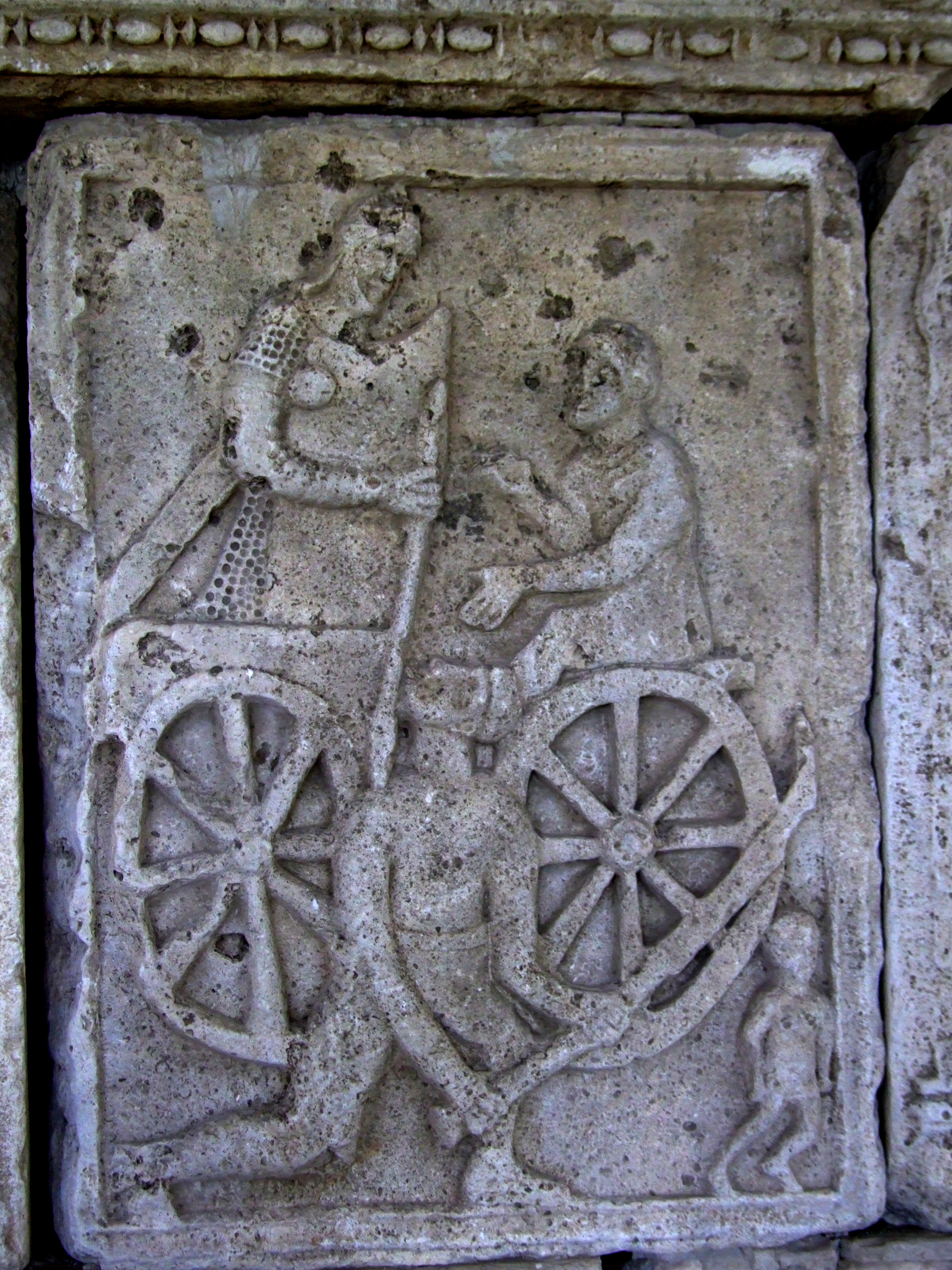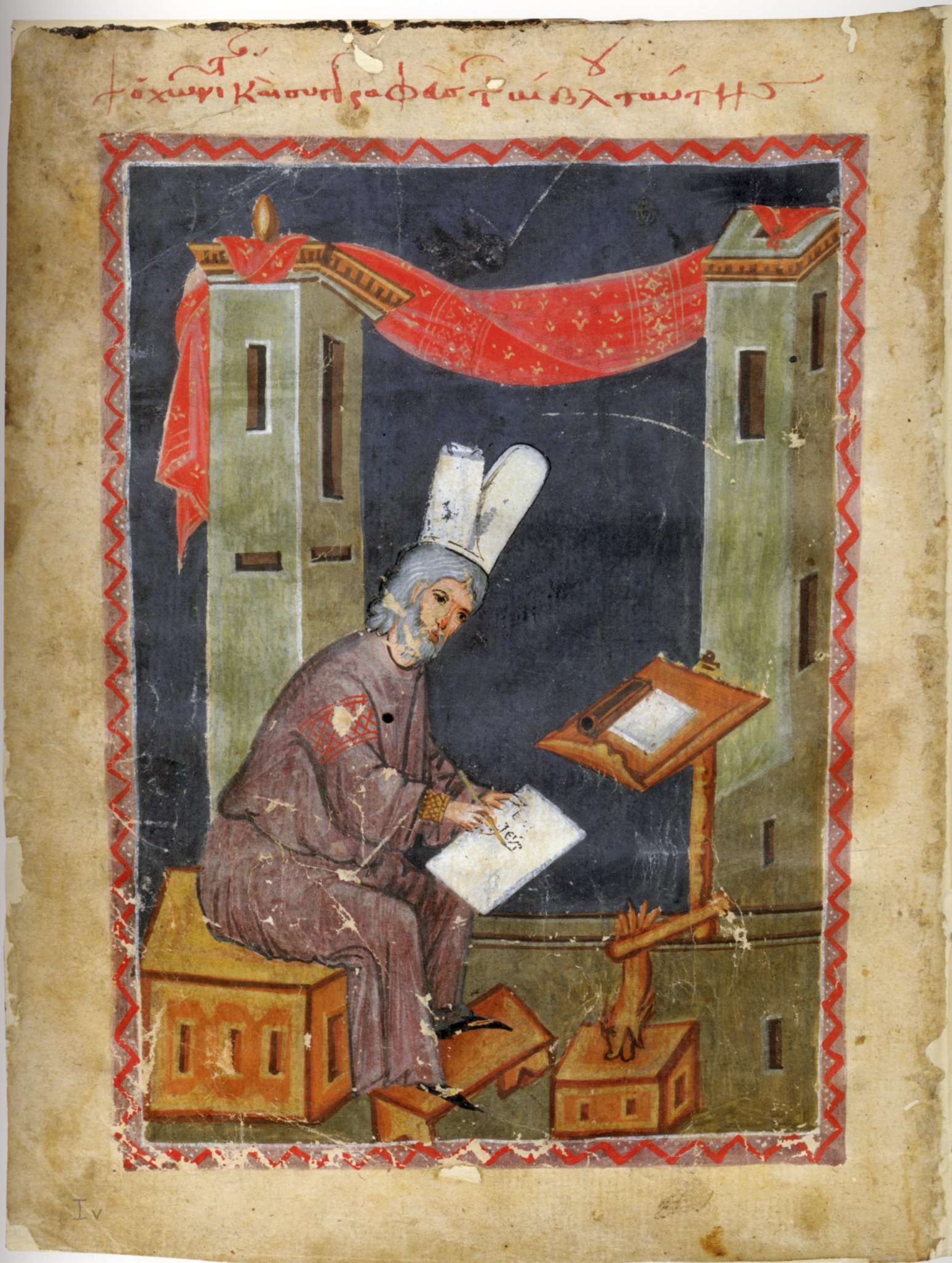|
Rhomphaia
The rhomphaia ( grc, ῥομφαία) was a close-combat bladed weapon used by the Thracians as early as 350-400 BC. Rhomphaias were weapons with a straight or slightly curved single-edged blade attached to a pole, which in most cases was considerably shorter than the blade. Although the rhomphaia was similar to the falx, most archaeological evidence suggests that rhomphaias were forged with straight or slightly curved blades, presumably to enable their use as both a thrusting and slashing weapon. The blade was constructed of iron and used a triangular cross section to accommodate the single cutting edge with a tang of rectangular cross section. Length varied, but a typical rhomphaia would have a blade of approximately 60–80 cm and a tang of approximately 50 cm. From the length of the tang, it can be presumed that, when attached to the hilt, this portion of the weapon would be of similar length to the blade. Usage Used almost exclusively by the Thracians, examples have ... [...More Info...] [...Related Items...] OR: [Wikipedia] [Google] [Baidu] |
Varangian Guard
The Varangian Guard ( el, Τάγμα τῶν Βαράγγων, ''Tágma tōn Varángōn'') was an elite unit of the Byzantine Army from the tenth to the fourteenth century who served as personal bodyguards to the Byzantine emperors. The Varangian Guard was known for being primarily composed of recruits from northern Europe, including mainly Norsemen from Scandinavia but also Anglo-Saxons from England. The recruitment of distant foreigners from outside Byzantium to serve as the emperor's personal guard was pursued as a deliberate policy, as they lacked local political loyalties and could be counted upon to suppress revolts by disloyal Byzantine factions. The Rus' provided the earliest members of the Varangian Guard. They were in Byzantine service from as early as 874. The Guard was first formally constituted under Emperor Basil II in 988, following the Christianization of Kievan Rus' by Vladimir I of Kiev. Vladimir, who had recently usurped power in Kiev with an army of Varangi ... [...More Info...] [...Related Items...] OR: [Wikipedia] [Google] [Baidu] |
Isidore Of Seville
Isidore of Seville ( la, Isidorus Hispalensis; c. 560 – 4 April 636) was a Spanish scholar, theologian, and archbishop of Seville. He is widely regarded, in the words of 19th-century historian Montalembert, as "the last scholar of the ancient world". At a time of disintegration of classical culture, aristocratic violence and widespread illiteracy, Isidore was involved in the conversion of the Arian Visigothic kings to Catholicism, both assisting his brother Leander of Seville and continuing after his brother's death. He was influential in the inner circle of Sisebut, Visigothic king of Hispania. Like Leander, he played a prominent role in the Councils of Toledo and Seville. His fame after his death was based on his ''Etymologiae'', an etymological encyclopedia that assembled extracts of many books from classical antiquity that would have otherwise been lost. This work also helped standardize the use of the period ( full stop), comma, and colon. Since the early ... [...More Info...] [...Related Items...] OR: [Wikipedia] [Google] [Baidu] |
Anna Komnene
Anna Komnene ( gr, Ἄννα Κομνηνή, Ánna Komnēnḗ; 1 December 1083 – 1153), commonly Latinized as Anna Comnena, was a Byzantine princess and author of the ''Alexiad'', an account of the reign of her father, the Byzantine emperor, Alexios I Komnenos. The ''Alexiad'' is the most important primary source of Byzantine history of the late 11th and early 12th centuries. Although she is best known as the author of the ''Alexiad'', Anna played an important part in the politics of the time and attempted to depose her brother, John II Komnenos, as emperor and seize the throne herself.Hanawalt 1982, p. 303. At birth, Anna was betrothed to Constantine Doukas,Hanawalt 1982, p. 303. and she grew up in his mother's household.Neville 2016, p. 2. She was well-educated in "Greek literature and history, philosophy, theology, mathematics, and medicine." Anna and Constantine were next in the line to throne until Anna's younger brother, John II Komnenos, became the heir in 1092. Constan ... [...More Info...] [...Related Items...] OR: [Wikipedia] [Google] [Baidu] |
Andronikos I Komnenos
Andronikos I Komnenos ( gr, Ἀνδρόνικος Κομνηνός; – 12 September 1185), Latinization of names, Latinized as Andronicus I Comnenus, was Byzantine emperor from 1183 to 1185. He was the son of Isaac Komnenos (son of Alexios I), Isaac Komnenos and the grandson of the emperor Alexios I Komnenos, Alexios I. In later Byzantine historiography, Andronikos I became known under the epithet "Misophaes" ("Hater of Sunlight") in reference to the great number of enemies he had Political mutilation in Byzantine culture, blinded. Early years Andronikos Komnenos was born around 1118. Most of what is known of him is from the writings of the historian Niketas Choniates,Niketas Choniates, ''Annals,'' XIX. certain passages in a work by Eustathios, 'The Capture of Thessaloniki', or inferred by later historians of the Byzantine Empire. He was handsome and eloquent, active, hardy, courageous, a great general and an able politician, but also licentious. His early years were spent ... [...More Info...] [...Related Items...] OR: [Wikipedia] [Google] [Baidu] |
Niketas Choniates
Niketas or Nicetas Choniates ( el, Νικήτας Χωνιάτης; c. 1155 – 1217), whose actual surname was Akominatos (Ἀκομινάτος), was a Byzantine Greek government official and historian – like his brother Michael Akominatos, whom he accompanied to Constantinople from their birthplace Chonae (from which came his nickname, "Choniates" meaning "person from Chonae"). Nicetas wrote a history of the Eastern Roman Empire from 1118 to 1207. Life Nicetas Akominatos was born to wealthy parents around or after 1150 in Phrygia in the city of Chonae (near the modern Honaz in Turkey). Bishop Nicetas of Chonae baptized and named the infant; later he was called "Choniates" after his birthplace. When he was nine, his father dispatched him with his brother Michael to Constantinople to receive an education. Niketas' older brother greatly influenced him during the early stages of his life. He initially secured a post in the civil service, and held important appointments under t ... [...More Info...] [...Related Items...] OR: [Wikipedia] [Google] [Baidu] |
Dane Axe
The Dane axe is an early type of battle axe, primarily used during the transition between the European Viking Age and early Middle Ages. Other names for the weapon include English long axe, Danish axe, and hafted axe. Construction Most axes, both in period illustrations and extant artifact, that fall under the description of Danish axe possess type L or type M heads according to the Petersen axe typology. Both types consist of a wide, thin blade, with pronounced "horns" at both the toe and heel of the bit. Cutting surfaces vary, but is generally between . Type L blades tend to be smaller, with the toe of the bit swept forward for superior shearing capability. Later type M blades are typically larger overall, with a more symmetrical toe and heel. The blade itself was reasonably light and forged very thin, making it superb for cutting. The thickness of the body on top the edge is as thin as 2 mm. Many of these axes were constructed with a reinforced bit, typically of a highe ... [...More Info...] [...Related Items...] OR: [Wikipedia] [Google] [Baidu] |
Thracian Language
The Thracian language () is an extinct and poorly attested language, spoken in ancient times in Southeast Europe by the Thracians. The linguistic affinities of the Thracian language are poorly understood, but it is generally agreed that it was an Indo-European language with satem features. A contemporary, neighboring language, Dacian is usually regarded as closely related to Thracian. However, there is insufficient evidence with respect to either language to ascertain the nature of this relationship. The point at which Thracian became extinct is a matter of dispute. However, it is generally accepted that Thracian was still in use in the 6th century AD: Antoninus of Piacenza wrote in 570 that there was a monastery in the Sinai, at which the monks spoke Greek, Latin, Syriac, Egyptian, and Bessian – a Thracian dialect. Other theories about Thracian remain controversial. A classification put forward by some linguists, such as Harvey Mayer, suggests that Thracian (and Dacian) ... [...More Info...] [...Related Items...] OR: [Wikipedia] [Google] [Baidu] |
Weapon
A weapon, arm or armament is any implement or device that can be used to deter, threaten, inflict physical damage, harm, or kill. Weapons are used to increase the efficacy and efficiency of activities such as hunting, crime, law enforcement, self-defense, warfare, or suicide. In broader context, weapons may be construed to include anything used to gain a tactical, strategic, material or mental advantage over an adversary or enemy target. While ordinary objects – sticks, rocks, bottles, chairs, vehicles – can be used as weapons, many objects are expressly designed for the purpose; these range from simple implements such as clubs, axes and swords, to complicated modern firearms, tanks, intercontinental ballistic missiles, biological weapons, and cyberweapons. Something that has been re-purposed, converted, or enhanced to become a weapon of war is termed weaponized, such as a weaponized virus or weaponized laser. History The use of weapons is a major driver of cult ... [...More Info...] [...Related Items...] OR: [Wikipedia] [Google] [Baidu] |
Fire
Fire is the rapid oxidation of a material (the fuel) in the exothermic chemical process of combustion, releasing heat, light, and various reaction Product (chemistry), products. At a certain point in the combustion reaction, called the ignition point, flames are produced. The ''flame'' is the visible portion of the fire. Flames consist primarily of carbon dioxide, water vapor, oxygen and nitrogen. If hot enough, the gases may become ionized to produce Plasma (physics), plasma. Depending on the substances alight, and any impurities outside, the color of the flame and the fire's Intensity (heat transfer), intensity will be different. Fire in its most common form can result in conflagration, which has the potential to cause physical damage through burning. Fire is an important process that affects ecological systems around the globe. The positive effects of fire include stimulating growth and maintaining various ecological systems. Its negative effects include hazard to life and pr ... [...More Info...] [...Related Items...] OR: [Wikipedia] [Google] [Baidu] |
Lightning
Lightning is a naturally occurring electrostatic discharge during which two electric charge, electrically charged regions, both in the atmosphere or with one on the land, ground, temporarily neutralize themselves, causing the instantaneous release of an average of one Joule, gigajoule of energy. This discharge may produce a wide range of electromagnetic radiation, from heat created by the rapid movement of electrons, to brilliant flashes of visible light in the form of black-body radiation. Lightning causes thunder, a sound from the shock wave which develops as gases in the vicinity of the discharge experience a sudden increase in pressure. Lightning occurs commonly during thunderstorms as well as other types of energetic weather systems, but volcanic lightning can also occur during volcanic eruptions. The three main kinds of lightning are distinguished by where they occur: either inside a single Cumulonimbus cloud, thundercloud (intra-cloud), between two clouds (cloud-to-cl ... [...More Info...] [...Related Items...] OR: [Wikipedia] [Google] [Baidu] |









